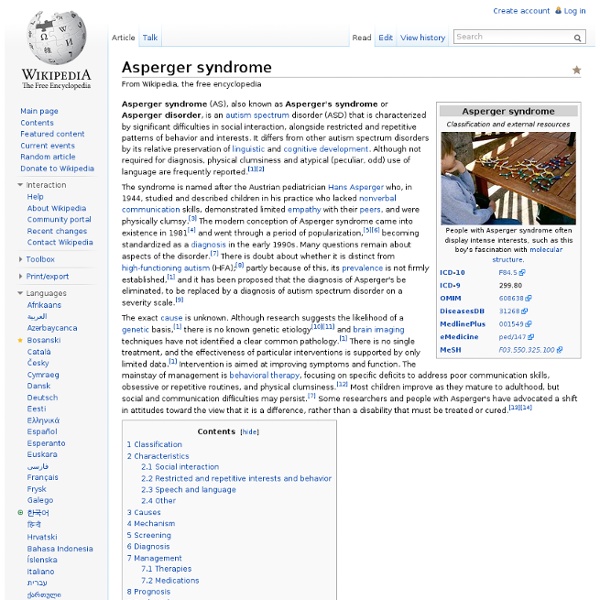Nootropic
Nootropics (/noʊ.əˈtrɒpɨks/ noh-ə-TROP-iks), also referred to as smart drugs, memory enhancers, neuro enhancers, cognitive enhancers, and intelligence enhancers, are drugs, supplements, nutraceuticals, and functional foods that improve one or more aspects of mental function, such as working memory, motivation, and attention.[1][2] The word nootropic was coined in 1972 by the Romanian Dr. Corneliu E. Giurgea,[3][4] derived from the Greek words νους nous, or "mind", and τρέπειν trepein meaning to bend or turn.[5] Availability and prevalence[edit] At present, there are only a few drugs which have been shown to improve some aspect of cognition in medical reviews.
What is Asperger syndrome?
Here we explain more about Asperger syndrome - a form of autism - including the three main difficulties that people with Asperger syndrome share, how many people have the condition, and what may cause it. As soon as we meet a person we make judgements about them. From their facial expression, tone of voice and body language we can usually tell whether they are happy, angry or sad and respond accordingly. People with Asperger syndrome can find it harder to read the signals that most of us take for granted.
Asperger Syndrome Information Page
Asperger syndrome (AS) is a developmental disorder. It is an autism spectrum disorder (ASD), one of a distinct group of neurological conditions characterized by a greater or lesser degree of impairment in language and communication skills, as well as repetitive or restrictive patterns of thought and behavior. Other ASDs include: classic autism, Rett syndrome, childhood disintegrative disorder, and pervasive developmental disorder not otherwise specified (usually referred to as PDD-NOS).
Jorge Luis Borges
Jorge Francisco Isidoro Luis Borges, KBE (Spanish: [ˈxorxe ˈlwis ˈβorxes] In 1914 his family moved to Switzerland, where he studied at the Collège de Genève. The family travelled widely in Europe, including stays in Spain.
Judith Ayre - Process Experiential Emotion Focused Therapy (PEEFT) for individuals and couples.
Process-Experiential Emotion-Focused Therapy (PEEFT) Process-Experiential Emotion-Focused Therapy (PEEFT) is a totally holistic approach that suits many different people. It can be very helpful for people who either find it hard to regulate their emotions or who feel that their emotions are spilling over uncomfortably into other areas of their life. Equally, it is effective for people who notice that they experience little or no emotion in their life or who are perceived by others to 'live in their heads' or be too 'ultra-rational' too much of the time. History of Process-Experiential Emotion-Focused Therapy (PEEFT) in Melbourne, Australia In the 1990s, Dr George Wills of LaTrobe University became interested in the work of Robert Elliott, Laura Rice and Les Greenberg.
Hedgehog's Dilemma
Both Arthur Schopenhauer and Sigmund Freud have used this situation to describe what they feel is the state of individual in relation to others in society. The hedgehog's dilemma suggests that despite goodwill, human intimacy cannot occur without substantial mutual harm, and what results is cautious behavior and weak relationships. With the hedgehog's dilemma, one is recommended to use moderation in affairs with others both because of self-interest, as well as out of consideration for others. The hedgehog's dilemma is used to explain introversion and isolationism. Schopenhauer[edit] The concept originates in the following parable from the German philosopher Arthur Schopenhauer's Parerga und Paralipomena, Volume II, Chapter XXXI, Section 396:[1]
Paraceratherium
Paraceratherium, also commonly known as Indricotherium or Baluchitherium (see taxonomic discussion below), is an extinct genus of gigantic hornless rhinoceros-like mammals of the family Hyracodontidae, endemic to Eurasia and Asia during the Oligocene epoch.[2] It was first discovered in 1910 in Balochistan of what is now Pakistan, hence the name, during an expedition by the English paleontologist and Cambridge University Museum of Zoology director Sir Clive Forster Cooper.[3] Description[edit] Restoration
Cognitive behavioral therapy
CBT has been demonstrated to be effective for the treatment of a variety of conditions, including mood, anxiety, personality, eating, substance abuse, tic, and psychotic disorders. Many CBT treatment programs for specific disorders have been evaluated for efficacy; the health-care trend of evidence-based treatment, where specific treatments for symptom-based diagnoses are recommended, has favored CBT over other approaches such as psychodynamic treatments.[3] However, other researchers have questioned the validity of such claims to superiority over other treatments.[4][5] History[edit]
Here’s A Special Aspergers Solution: Social Behavior Mapping
Social Behavior Mapping Can Save Your Sanity! How many parents are pulling their hair out from all the incident reports they are getting regarding their kid’s behavior in school? How many Aspergers kids dread going to school because they don’t know what they are going to do wrong next?
Behemoth
Behemoth (/bɨˈhiːməθ/ or /ˈbiː.əməθ/, also /ˈbeɪ.əmɔːθ/; Hebrew: בהמות, behemoth (modern: behemot)) is a beast mentioned in Job 40:15–24. Suggested identities range from a mythological creature to an elephant, hippopotamus, rhinoceros or crocodile. Some creationists believe it to be a description of a sauropod.[1] Metaphorically, the name has come to be used for any extremely large or powerful entity. Plural as singular[edit]



